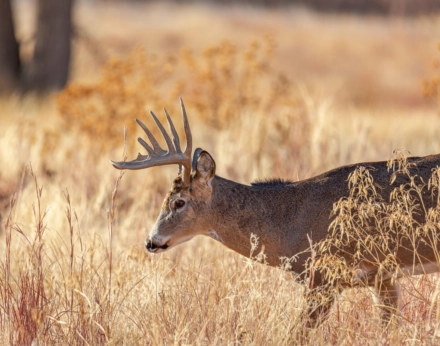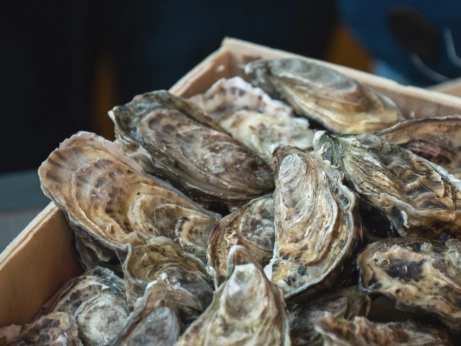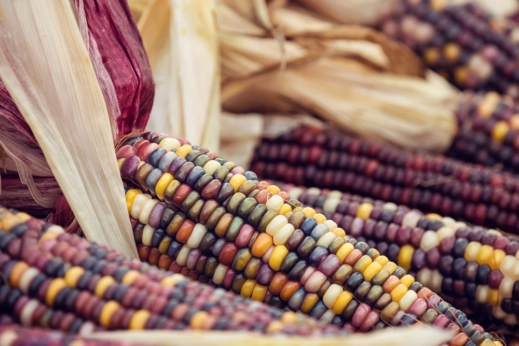What Foods Were Served At The First Thanksgiving?
The menu that day doesn't have all that much in common with the staples of a modern one.
What Foods Were Served At The First Thanksgiving?
The menu that day doesn't have all that much in common with the staples of a modern one.

by Shutterstock.
The meal usually thought of as the first Thanksgiving took place sometime around the harvest season in 1621 at the Plymouth Plantation in modern-day Massachusetts. But it shouldn’t come as a surprise that the menu that day doesn’t have all that much in common with the staples of a modern one.
This first celebration probably took place several weeks earlier in the year than it does today; the exact date is unknown but some estimates place it in late September or early October. Actually, the first feast in 1621 wasn’t really one of giving thanks, but rather a normal harvest holiday; it wasn’t until 1623 that the moral tone of Thanksgiving began to take shape. Additionally, some staples had yet to arrive from wherever they were originally found: potatoes from South America, sweet potatoes from the Caribbean, white flour from all over the Old World.
Aside from that though, we think that plenty of other classic Thanksgiving items were served, though it’s important to note that this is all guesswork – there are two brief passages about the feast from British colonists, one from the governor and one from a settler, which hardly provide a full menu, therefore any recreation is sheer guesswork on the part of historians.
On the plus side, there isn’t really anyone around who can disprove them. That said, we have a fairly good idea of what local tribes ate and we know roughly what the Pilgrims brought with them and what non-local crops had enough time to produce food by that time. Here’s a look:
Poultry
The wild turkey, both then and now, was commonly eaten in New England, but dispatches from Pilgrims indicate that it probably wasn’t the only, or even the primary, bird to be eaten at the first Thanksgiving. Today’s Plimouth Plantation organization suggests that ducks, geese, swans, and small birds like the now extinct passenger pigeon were probably served that evening.

Meat
Today it’s unusual to find any red meat on a Thanksgiving menu, but William Bradford, the governor of the Plymouth colony, wrote that deer (or venison) was a centerpiece of that 1621 meal.

Fish and shellfish
Oceanic representation is rare Thanksgiving today—though that may be changing. However, it seems likely that lobsters, mussels, oysters, clams, and fish like striped bass and eels made up a huge part of the early diet of the Pilgrims.

Corn
Modern sweet corn has little in common with the corn of the seventeenth century, which was likely multicolored flint corn (sometimes known as Indian corn today). Flint corn is most similar to the modern popcorn: an exceedingly hard, minimally starchy variety. Common preparations at the time, as attested to by Bradford, was typically hand-ground and then stewed to make a porridge.

Winter squash
Squash is native to North America, and pumpkin and other varieties of winter squash (hubbard, acorn, butternut) were almost certainly on the menu given their importance to the Wampanoag tribes at that time. Squash was typically boiled or roasted. Pies were not on the menu; historians guess that the Pilgrims’ supplies of butter, flour, and sugar were probably long gone by the fall of 1621.

Local fruits and vegetables
It’s easy to forget that so many of the crops we take for granted now would have been brand-new to the Pilgrims, but historians assume at least some would have made it to the table. Jerusalem artichokes (sometimes known as sunchokes), the root of the sunflower plant, are likely to have made an appearance. Same with a selection of beans, which probably included modern varieties like kidney and pinto. Beans were typically boiled in stews – the Wampanoag word for stew is sobaheg – and thickened with ground nuts like chestnut.

As for fruits, historians aren’t really sure. Blueberries, raspberries, gooseberries, and plums were commonly eaten at the time, sometimes dried and sometimes fresh, but they don’t appear specifically in either of the accounts of the first Thanksgiving. Same thing with cranberries – it was likely decades before people began boiling them with sugar to make the sauce we’re used to today.
English imports
It’s unlikely that any of the crops planted by the British settlers were providing much of anything in 1621; apples, for example, are not native to North America and wouldn’t bear fruit for at least ten years (and that’s a very optimistic guess). Further, the Pilgrims brought basically nothing that would last the full first year from their landing until the autumn of 1621; a list of the Mayflower’s provisions yields little that might have been present at the feast. Some hard cheese, maybe, or oats, or vinegar. Though it’s not likely that the remaining supplies would have been enough to feed the 50 Pilgrims and 90 Wampanoag who attended the first feast.
This story was originally published in 2016, and has been updated.
Follow us

This work is licensed under a Creative Commons Attribution-NoDerivatives 4.0 International License.
Want to republish a Modern Farmer story?
We are happy for Modern Farmer stories to be shared, and encourage you to republish our articles for your audience. When doing so, we ask that you follow these guidelines:
Please credit us and our writers
For the author byline, please use “Author Name, Modern Farmer.” At the top of our stories, if on the web, please include this text and link: “This story was originally published by Modern Farmer.”
Please make sure to include a link back to either our home page or the article URL.
At the bottom of the story, please include the following text:
“Modern Farmer is a nonprofit initiative dedicated to raising awareness and catalyzing action at the intersection of food, agriculture, and society. Read more at <link>Modern Farmer</link>.”
Use our widget
We’d like to be able to track our stories, so we ask that if you republish our content, you do so using our widget (located on the left hand side of the article). The HTML code has a built-in tracker that tells us the data and domain where the story was published, as well as view counts.
Check the image requirements
It’s your responsibility to confirm you're licensed to republish images in our articles. Some images, such as those from commercial providers, don't allow their images to be republished without permission or payment. Copyright terms are generally listed in the image caption and attribution. You are welcome to omit our images or substitute with your own. Charts and interactive graphics follow the same rules.
Don’t change too much. Or, ask us first.
Articles must be republished in their entirety. It’s okay to change references to time (“today” to “yesterday”) or location (“Iowa City, IA” to “here”). But please keep everything else the same.
If you feel strongly that a more material edit needs to be made, get in touch with us at [email protected]. We’re happy to discuss it with the original author, but we must have prior approval for changes before publication.
Special cases
Extracts. You may run the first few lines or paragraphs of the article and then say: “Read the full article at Modern Farmer” with a link back to the original article.
Quotes. You may quote authors provided you include a link back to the article URL.
Translations. These require writer approval. To inquire about translation of a Modern Farmer article, contact us at [email protected]
Signed consent / copyright release forms. These are not required, provided you are following these guidelines.
Print. Articles can be republished in print under these same rules, with the exception that you do not need to include the links.
Tag us
When sharing the story on social media, please tag us using the following: - Twitter (@ModFarm) - Facebook (@ModernFarmerMedia) - Instagram (@modfarm)
Use our content respectfully
Modern Farmer is a nonprofit and as such we share our content for free and in good faith in order to reach new audiences. Respectfully,
No selling ads against our stories. It’s okay to put our stories on pages with ads.
Don’t republish our material wholesale, or automatically; you need to select stories to be republished individually.
You have no rights to sell, license, syndicate, or otherwise represent yourself as the authorized owner of our material to any third parties. This means that you cannot actively publish or submit our work for syndication to third party platforms or apps like Apple News or Google News. We understand that publishers cannot fully control when certain third parties automatically summarize or crawl content from publishers’ own sites.
Keep in touch
We want to hear from you if you love Modern Farmer content, have a collaboration idea, or anything else to share. As a nonprofit outlet, we work in service of our community and are always open to comments, feedback, and ideas. Contact us at [email protected].by Dan Nosowitz, Modern Farmer
November 15, 2016
Modern Farmer Weekly
Solutions Hub
Innovations, ideas and inspiration. Actionable solutions for a resilient food system.
ExploreExplore other topics
Share With Us
We want to hear from Modern Farmer readers who have thoughtful commentary, actionable solutions, or helpful ideas to share.
SubmitNecessary cookies are absolutely essential for the website to function properly. This category only includes cookies that ensures basic functionalities and security features of the website. These cookies do not store any personal information.
Any cookies that may not be particularly necessary for the website to function and are used specifically to collect user personal data via analytics, ads, other embedded contents are termed as non-necessary cookies.
i agree!
son,
Tell me.
Love this
Or i’ll tell your mother